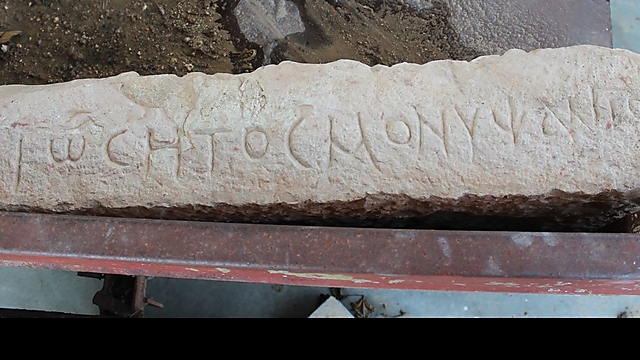Meredith J.C. Warren, Lecturer in Biblical and Religious Studies at the University of Sheffield, wrote the following article, published in the Internet publication
The Conversation,
March 16, 2016 (bold in original, links inserted by blogger):
Was Jesus really nailed to the cross?
Jesus’s crucifixion is probably one of the most familiar images to emerge from Christianity. Good Friday, one of the holiest days in the Christian calendar, marks the event. But what was crucifixion? And why was Jesus killed that way?
Crucifixion was a Roman method of punishment. Suspended from a large cross, a victim would eventually die from asphyxiation or exhaustion – it was long, drawn-out, and painful. It was used to publicly humiliate slaves and criminals (not always to kill them), and as an execution method was usually reserved for individuals of very low status or those whose crime was against the state. This is the reason given in the Gospels for Jesus’s crucifixion: as King of the Jews, Jesus challenged Roman imperial supremacy (Matt 27:37; Mark 15:26; Luke 23:38; John 19:19–22).
Crucifixion could be carried out in a number of ways. In Christian tradition, nailing the limbs to the wood of the cross is assumed, with debate centring on whether nails would pierce hands or the more structurally sound wrists. But Romans did not always nail crucifixion victims to their crosses, and instead sometimes tied them in place with rope. In fact, the only archaeological evidence for the practice of nailing crucifixion victims is an ankle bone from the tomb of Jehohanan, a man executed in the first century CE.
So was Jesus nailed to the cross?
Gospel accounts
Some early Gospels, such as the Gospel of Thomas, don’t include the narrative of Jesus’s crucifixion, choosing instead to focus on his teaching. But Jesus’s death by crucifixion is one of the things that all four canonical Gospels agree on. Matthew, Mark, Luke, and John, all include the crucifixion event in their own slightly different ways.
None of the Gospels in the New Testament mentions whether Jesus was nailed or tied to the cross. However, the Gospel of John reports wounds in the risen Jesus’s hands. It is this passage, perhaps, that has led to the overwhelming tradition that Jesus’s hands and feet were nailed to the cross, rather than tied to it.
The Gospel of Peter, a non-canonical gospel from the first or second century CE, specifically describes in verse 21 how after Jesus had died, the nails were removed from his hands. The Gospel of Peter also famously includes the cross itself as an active character in the Passion narrative. In verses 41-42 the cross speaks, responding with its own voice to God: “And they were hearing a voice from the heavens saying, ‘Have you made proclamation to the fallen-asleep?’ And an obeisance was heard from the cross, ‘Yes.’” Tradition is clearly of paramount importance to this text.
Over the past few years, several people have claimed to have found the actual nails with which Jesus was crucified. Each time, biblical scholars and archaeologists have rightly pointed out the assumptions and misinterpretations of evidence behind these claims. Curiously, this fixation on the nails persists, despite the fact that the earliest gospels make no mention of Jesus being nailed to the cross.
Depictions of the crucifixion
It isn’t surprising that Christians took a while to embrace the image of Christ on the cross, given that crucifixion was a humiliating way to die. What is surprising is what the earliest image of the crucifixion turns out to be. Rather than the devotional icons with which we are familiar – pictures that glorify Jesus’s death –
this earliest image appears to be some late second-century graffiti mocking Christians.
Called the Alexamenos Graffito, the image shows a figure with the head of a donkey on a cross with the words: “Alexamenos worships his God.” This was apparently a common accusation in antiquity, as Minucius Felix(Octavius 9.3; 28.7) and Tertullian (Apology 16.12) both attest. Since the graffito was clearly not made by a Christian, this image suggests that non-Christians were familiar with some core elements of Christian belief as early as the second century.
Gemstones, some used for magical purposes, also provide some of our earliest depictions of the crucified Jesus. This second or third century
piece of carved jasper depicts a man on a cross surrounded by magic words.
Another very early image of the crucifixion is found carved into the face of a carnelian gemstone made into a ring.
Scholars think that the Constanza gemstone, as it is known, dates from the fourth century CE. In this depiction, Jesus’s hands do not appear to be nailed to the cross, since they fall naturally, as if he is tied at the wrists.
Since the evidence from antiquity doesn’t provide a clear answer as to whether Jesus was nailed or tied to his cross, it’s tradition that dictates this common depiction. Those who have seen the film The Passion of the Christ will recall how much time the director, Mel Gibson, devoted just to the act of nailing Jesus onto the cross —- almost five whole minutes.
Given the relative silence on the act of crucifixion in the Gospels, this stands out as a graphic expansion. One of the only films that does not assume that crucifixion involved nails is Monty Python’s Life of Brian, which shows multiple crucifixion victims, though not Jesus, tied to their crosses.
Eventually, Emperor Constantine put an end to crucifixion as a method of execution, not for ethical reasons, but out of respect for Jesus. But in the end, it is the enduring image of the cross, and not the matter of whether nails or ropes were used, that most firmly evokes the death of Jesus in art and tradition.
The question as to whether or not the Lord Jesus Christ was nailed to the cross is legitimate, but Professor Warren should be more thorough in reading the Bible before saying that "evidence from antiquity doesn’t provide a clear answer as to whether Jesus was nailed or tied to his cross." In fact, scripture does provide evidence that Jesus was nailed to the cross (real scripture, that is; the "Gospels" of Thomas and Peter should be ignored as the postbiblical and unbiblical forgeries they are).
From the Old Testament we have Psalm 22, universally acknowledged as a messianic prophecy:
I am poured out like water, and all my bones are out of joint: my heart is like wax; it is melted in the midst of my bowels...
...For dogs have compassed me: the assembly of the wicked have inclosed me: they pierced my hands and my feet. Psalms 22:14, 16
Then there's Zechariah 12:10:
And I will pour upon the house of David, and upon the inhabitants of Jerusalem, the spirit of grace and of supplications: and they shall look upon me whom they have pierced, and they shall mourn for him, as one mourneth for his only son, and shall be in bitterness for him, as one that is in bitterness for his firstborn.
While some might say that this is referring to Jesus' side being pierced by a spear after His death (
John 19:34), the passage in Zechariah is addressed to "the house of David and the inhabitants of Jerusalem," which would indicate that the piercing being referred to is the crucifixion. The spear that pierced Jesus' side after his death was wielded by a Roman soldier, and is thus not a fulfillment of Zechariah 12:10.
In the New Testament, we have the first post-resurrection encounter between the Lord and Thomas in John 20:24-29:
But Thomas, one of the twelve, called Didymus, was not with them when Jesus came.
The other disciples therefore said unto him, We have seen the Lord. But he said unto them, Except I shall see in his hands the print of the nails, and put my finger into the print of the nails, and thrust my hand into his side, I will not believe.
And after eight days again his disciples were within, and Thomas with them: then came Jesus, the doors being shut, and stood in the midst, and said, Peace be unto you.
Then saith he to Thomas, Reach hither thy finger, and behold my hands; and reach hither thy hand, and thrust it into my side: and be not faithless, but believing.
And Thomas answered and said unto him, My Lord and my God.
Jesus saith unto him, Thomas, because thou hast seen me, thou hast believed: blessed are they that have not seen, and yet have believed.
It's worth noting that when Thomas said that he wouldn't believe until he saw the nail prints in Jesus' hands (and the wrist was regarded as part of the hand), none of the other disciples told him that there were no nail prints to be seen. As for the lack of mention of the nails in the Gospel narratives of the crucifixion, the writers, under the inspiration of the Holy Spirit, wrote with the belief that the reader would understand that crucifixion referred to nailing, and would have otherwise noted the distinction. And of course, Jesus showed Thomas His hands, and the evidence was enough to dispel all of Thomas's doubts.
In Acts 2:23, Peter accuses the Jews of crucifying Jesus; where the
King James Version uses the phrase "crucified and slain," the
New International Version uses the phrase "put him to death by nailing him to the cross." The
New American Standard Bible rendition of this verse also states that He was "nailed to a cross."
In Colossians, Paul is writing about the believer's new identity in Christ:
And you, being dead in your sins and the uncircumcision of your flesh, hath he quickened together with him, having forgiven you all trespasses;
Blotting out the handwriting of ordinances that was against us, which was contrary to us, and took it out of the way, nailing it to his cross; Colossians 2:13-14
Most important, it must be kept in mind that "without the shedding of blood is no remission" (
Hebrews 9:22). In order to pay the penalty for our sins, Jesus had to die in a manner that involved the shedding of His blood; anything less wouldn't have satisfied His Father's requirements of justice. Indeed, Jesus declared that He had accomplished what He set out to do when He said just before He died, "It is finished" (
John 19:30), an accounting term meaning "paid in full." As an aside, please note that Jesus was on the cross when He announced that He had paid the debt in full, contrary to heretical "faith" teachers who claim that Jesus had to go to Hell to finish His mission.
The efficacious death of Jesus on the cross is prefigured in the Old Testament by such ordinances as the Passover (
Exodus 12:1-27, 43-49)--where God promised to pass over houses where He saw the blood (
Exodus 12:13)--and the sin offering (
Leviticus 9:1-9), where the blood that wasn't put on the horns of the altar was to be poured out (
Leviticus 9:9).
Given the biblical evidence, we can confidently state that the Lord Jesus Christ was indeed nailed to the cross.












































